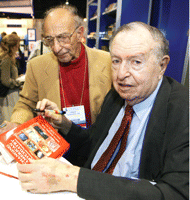Melvin Sabshin, M.D., APA medical director from 1974 to 1997, died June 4 in London, England, where he had been living since his retirement. He was 85.
Sabshin led APA during a period of sweeping change, and he was arguably the most consequential figure in American psychiatry in the second half of the 20th century.
"Dr. Sabshin's exemplary leadership helped to shape a new American psychiatry at a time of great change," said James H. Scully Jr., M.D., APA's current medical director and CEO, in a statement. "His substantial skills and vision greatly enhanced APA, leaving it much larger and stronger."
Membership increased dramatically during Sabshin's tenure. Other highlights of his leadership included publication of new editions of the Diagnostic and Statistical Manual of Mental Disorders; creation of American Psychiatric Press Inc.; development of APA's practice-guidelines project; and providing major upgrades of the Association's efforts in research, advocacy, education, and public affairs.
Sabshin also increased the organization's international involvement, including working with the World Psychiatric Association and others to help end the use of psychiatry to suppress political dissent in the Soviet Union and other parts of the world (Psychiatric News, November 5, 2010; November 19, 2010; December 3, 2010).
APA President John Oldham, M.D., called Sabshin "an esteemed leader, an intellectual catalyst, and a consummate diplomat who was central to the evolution of American psychiatry" (see
The Sabshin Legacy of Hope).
He added, "As medical director of the American Psychiatric Association from 1974 to 1997, Dr. Sabshin understood that psychiatry, as a profession, needed a new direction, resolved to be part of the change, and succeeded."
Sabshin himself believed that his most important contribution, as detailed in his 2008 book Changing American Psychiatry (published by APPI), was to help move psychiatric diagnosis and treatment toward a more empirical, evidence-based nosology.
In that book, he wrote: "As an active participant in the many steps in the establishment of DSM-III and DSM-IV, I joined other psychiatric leaders in advocating a new evidence-based profession. One of my motives in accepting the post of Medical Director of APA was to assist in a transition from an ideologically oriented profession to one that developed and maintained a genuine scientific base."
APA leaders and staff colleagues remember a far-sighted leader, but also a warm and kind-hearted mentor.
"All of us who knew and worked with Mel are feeling a professional and institutional loss, but also a personal loss," said former APA President Carolyn Robinowitz, M.D., who worked for Sabshin as deputy medical director of APA for 18 years. "A brilliant strategist, his outstanding leadership had a profound impact on our profession both here and abroad. In addition to his political wisdom, and clinical acumen, Mel was a marvelous mentor who adopted a generation of psychiatrists and encouraged and inspired them in their careers, while strengthening the science, education, and care in our field."
Past APA President Steven Sharfstein, M.D., who served as an APA deputy medical director under Sabshin from 1983 to 1986, called him "a giant" in American and world psychiatry. "He led APA at a crucial time when psychiatry returned to its medical specialty roots and began its battle for parity in the financing of care," Sharfstein said. "He was warm and caring, with a wonderful wit and many puns, and he was a fabulous mentor. As a deputy medical director, I learned more about management from Mel than from any course or textbook. We will all miss him."
Sabshin completed high school at age 14 and college undergraduate study at age 17. After brief service in the U.S. Army, he completed medical school and residency at Tulane University. He then took a position at the Michael Reese Hospital in Chicago and in 1961 became head of the Department of Psychiatry at the University of Illinois College of Medicine. During this time he became active in APA and was elected to the Board of Trustees; and in 1974 he was chosen to serve as the Association's medical director.
He is survived by his wife, Marion Bennathan, his son, James Sabshin, M.D., and four granddaughters.

